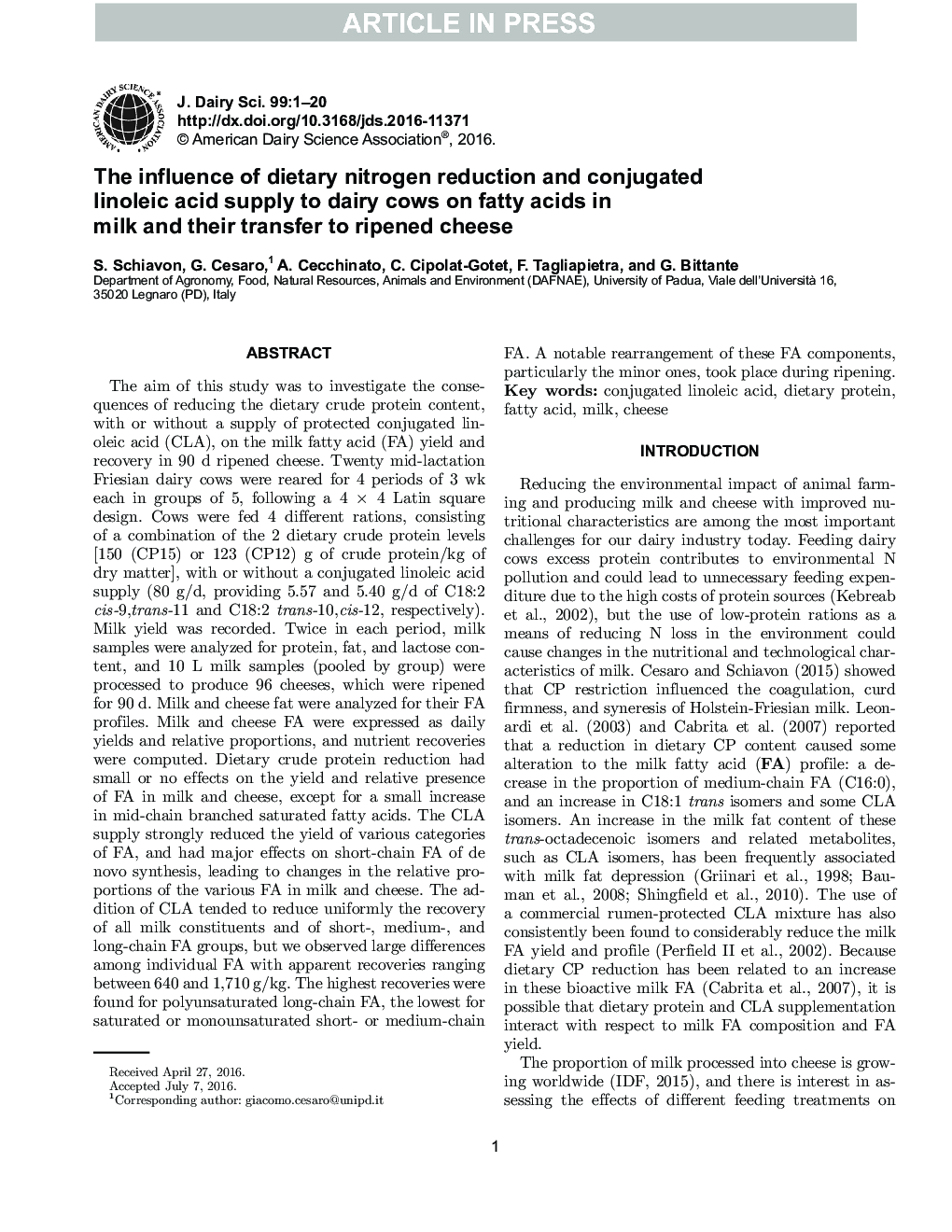| کد مقاله | کد نشریه | سال انتشار | مقاله انگلیسی | نسخه تمام متن |
|---|---|---|---|---|
| 5542652 | 1402521 | 2016 | 20 صفحه PDF | دانلود رایگان |
عنوان انگلیسی مقاله ISI
The influence of dietary nitrogen reduction and conjugated linoleic acid supply to dairy cows on fatty acids in milk and their transfer to ripened cheese
ترجمه فارسی عنوان
تأثیر کاهش نیتروژن غذایی و عرضه اسید لینولئیک کانژوگه به گاوهای شیری بر روی اسید های چرب شیر و انتقال آنها به پنیر
دانلود مقاله + سفارش ترجمه
دانلود مقاله ISI انگلیسی
رایگان برای ایرانیان
کلمات کلیدی
اسید لینولئیک کانژوگه پروتئین غذایی، اسید چرب، شیر، پنیر،
موضوعات مرتبط
علوم زیستی و بیوفناوری
علوم کشاورزی و بیولوژیک
علوم دامی و جانورشناسی
چکیده انگلیسی
The aim of this study was to investigate the consequences of reducing the dietary crude protein content, with or without a supply of protected conjugated linoleic acid (CLA), on the milk fatty acid (FA) yield and recovery in 90Â d ripened cheese. Twenty mid-lactation Friesian dairy cows were reared for 4 periods of 3Â wk each in groups of 5, following a 4Â ÃÂ 4 Latin square design. Cows were fed 4 different rations, consisting of a combination of the 2 dietary crude protein levels [150 (CP15) or 123 (CP12) g of crude protein/kg of dry matter], with or without a conjugated linoleic acid supply (80Â g/d, providing 5.57 and 5.40Â g/d of C18:2 cis-9,trans-11 and C18:2 trans-10,cis-12, respectively). Milk yield was recorded. Twice in each period, milk samples were analyzed for protein, fat, and lactose content, and 10 L milk samples (pooled by group) were processed to produce 96 cheeses, which were ripened for 90Â d. Milk and cheese fat were analyzed for their FA profiles. Milk and cheese FA were expressed as daily yields and relative proportions, and nutrient recoveries were computed. Dietary crude protein reduction had small or no effects on the yield and relative presence of FA in milk and cheese, except for a small increase in mid-chain branched saturated fatty acids. The CLA supply strongly reduced the yield of various categories of FA, and had major effects on short-chain FA of de novo synthesis, leading to changes in the relative proportions of the various FA in milk and cheese. The addition of CLA tended to reduce uniformly the recovery of all milk constituents and of short-, medium-, and long-chain FA groups, but we observed large differences among individual FA with apparent recoveries ranging between 640 and 1,710Â g/kg. The highest recoveries were found for polyunsaturated long-chain FA, the lowest for saturated or monounsaturated short- or medium-chain FA. A notable rearrangement of these FA components, particularly the minor ones, took place during ripening.
ناشر
Database: Elsevier - ScienceDirect (ساینس دایرکت)
Journal: Journal of Dairy Science - Volume 99, Issue 11, November 2016, Pages 8759-8778
Journal: Journal of Dairy Science - Volume 99, Issue 11, November 2016, Pages 8759-8778
نویسندگان
S. Schiavon, G. Cesaro, A. Cecchinato, C. Cipolat-Gotet, F. Tagliapietra, G. Bittante,
